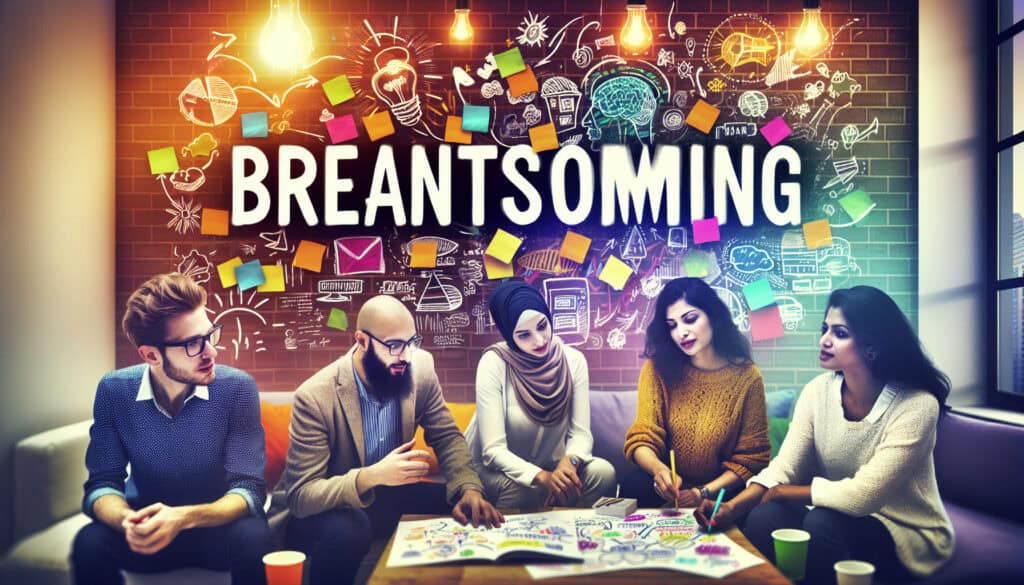Una tecnica di creatività di gruppo in cui si cerca di trovare una conclusione per un problema specifico raccogliendo un elenco di idee spontaneamente apportate dai membri.
- Metodologie: Ingegneria, Qualità
Brainstorming

Brainstorming
- Metodologia agile, Brainstorming, Creatività, Collaborazione interfunzionale, Pensiero progettuale, Ideazione, Innovazione, Tecniche di risoluzione dei problemi, Lavoro di squadra
Obiettivo:
Come si usa:
- Le sessioni di brainstorming sono tipicamente non strutturate e informali e i partecipanti sono incoraggiati a generare il maggior numero di idee possibile, senza critiche o giudizi.
Professionisti
- Può essere un modo divertente e coinvolgente per generare idee, può portare a un gran numero di idee in poco tempo e può essere utilizzato per risolvere un'ampia gamma di problemi.
Contro
- Può essere dominato da alcuni partecipanti vocali, può portare a molte idee che non sono pertinenti o fattibili e può non essere adatto a tutti i tipi di problemi.
Categorie:
- Ideazione, Risoluzione dei problemi
Ideale per:
- Generare un gran numero di idee per un problema specifico.
Il brainstorming è ampiamente utilizzato in varie fasi della progettazione di un prodotto, in particolare durante la fase di ideazione, in cui designer, ingegneri e team di marketing collaborano per esplorare soluzioni creative per una determinata sfida. Questo approccio informale è molto diffuso in settori come la tecnologia, i prodotti di consumo, l'automotive e la sanità, dove l'innovazione è fondamentale per rimanere competitivi. In genere, l'iniziativa di una sessione di brainstorming può essere guidata dai project manager, dai responsabili della progettazione o dai responsabili dell'innovazione e spesso include partecipanti diversi come ingegneri, progettisti, ricercatori e persino clienti per incoraggiare un'ampia gamma di prospettive e competenze. Tecniche come la mappatura mentale, la suddivisione in gruppi o il metodo "6-3-5" - in cui sei partecipanti generano tre idee ciascuno in cinque minuti - possono migliorare ulteriormente la generazione di idee. Il brainstorming consente anche di fondere rapidamente i concetti esistenti in nuovi prodotti. L'assenza di giudizio durante le sessioni incoraggia il pensiero audace, che può essere particolarmente utile quando si affrontano idee complesse. sfide di progettazione o l'esplorazione di nuove tecnologie. I team possono documentare i risultati e dare priorità alle idee da sviluppare ulteriormente o da prototipare, supportando il processo di progettazione iterativa comune nello sviluppo di ingegneria e prodotti. Le applicazioni di successo vanno dalla creazione di applicazioni digitali incentrate sull'utente all'innovazione di materiali sostenibili per la produzione, dimostrando che il programma versatilità in vari campi.
Fasi chiave di questa metodologia
- Stabilite un obiettivo o un problema chiaro per la sessione.
- Incoraggiare la generazione di idee senza filtri; tutte le idee devono essere espresse indipendentemente dalla loro fattibilità.
- Costruire sulle idee dell'altro; collegare ed elaborare i suggerimenti iniziali.
- Garantire la pari partecipazione di tutti i membri, incoraggiando gli individui più silenziosi a condividere.
- Utilizzare ausili visivi, come schizzi o mappe mentali, per rappresentare le idee in modo dinamico.
- Introducete suggerimenti o stimoli per stimolare il pensiero creativo quando le idee sono in fase di stallo.
- Mantenere l'energia; incoraggiare l'entusiasmo e la creatività durante tutta la sessione.
- Consentite idee spontanee e tangenti che possono portare a intuizioni preziose.
Suggerimenti per i professionisti
- Incorporate tecniche come il Round Robin e il Brainwriting per garantire una partecipazione paritaria e impedire che le voci dominanti mettano in ombra i membri più silenziosi del team.
- Stabilite vincoli di tempo specifici per le fasi di generazione delle idee seguite da periodi di relax per stimolare il pensiero divergente ed evitare l'affaticamento cognitivo.
- Documentare visivamente tutte le idee utilizzando strumenti come mappe mentali o lavagne digitali, favorendo un'atmosfera collaborativa e consentendo di sfruttare i contributi degli altri.
Leggere e confrontare diverse metodologie, raccomandiamo il
> Ampio archivio di metodologie <
insieme ad altre 400 metodologie.
I vostri commenti su questa metodologia o ulteriori informazioni sono benvenuti su sezione commenti qui sotto ↓ , così come tutte le idee o i link relativi all'ingegneria.
Contesto storico
1949
1950
1950
1960
1960
1960
1960
1940
1950
1950
1958
1960
1960
1960
1960
(se la data non è nota o non è rilevante, ad esempio "meccanica dei fluidi", viene fornita una stima approssimativa della sua notevole comparsa)















Post correlati
Questionari sul disagio muscoloscheletrico
Test multivariati (MVT)
Analisi di regressione multipla
Sistemi di cattura del movimento
Metodo MoSCoW
Test mediano dell'umore